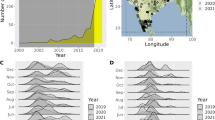Summary
To obtain insights into the organization and adaptive significance of seasonal migration by colonies of the giant honey bee,Apis dorsata, we monitored the arrivals and departures of colonies in a rain forest habitat in northeastern Thailand, compared patterns of honey bee abundance with other measures of habitat variability, and observed the role of dance communication in organizing the migratory departure of a colony. Colonies arrived in the area during the end of the dry season, reproduced, and then departed early in the rainy season. During the immigration phase, early-arriving colonies stayed only temporarily, as if assessing habitat quality. Colonies departing after a long stay always left barren combs behind, suggesting that they had left in response to deteriorating resource quality. These observations support the idea that migration allows colonies to track seasonally varying resources in different regions. Our observations of a colony preparing for migration revealed that the dance language is involved in organizing the colony's departure, but that dancers signal only the direction to be taken, rather than, as in dances to feeding sites, both the direction and distance of a particular location.
Similar content being viewed by others
References
Batschelet, E., 1981.Circular Statistics in Biology. London: Academic Press.
Daubenmire, R., 1972. Phenology and other characteristics of tropical semideciduous forest in northwestern Costa Rica.J. Ecol. 60:147–170.
Dingle, H., 1980. Ecology and evolution of migration. In:Animal migration, orientation, and navigation (S. A. Gauthreaux, Jr., Ed.), Academic Press, New York, pp. 1–101.
Dyer, F. C., 1985. Nocturnal orientation by the Asian honey beeApis dorsata.Anim. Behav. 33:769–774.
Dyer, F. C., 1991. Comparative studies of dance communication: Analysis of phylogeny and function. In:Diversity in the Genus Apis (D. R. Smith, Ed.), Westview Press, Boulder, Colorado, pp. 177–197.
Dyer, F. C. and T. D. Seeley, 1991 a. Nesting behavior and the evolution of worker tempo in for honey bee species.Ecology 72:156–170.
Dyer, F. C. and T. D. Seeley, 1991 b. Dance dialects and foraging range in three Asian honey bee species.Behav. Ecol. Sociobiol. 28:227–233.
Fletcher, D. J. C., 1978. The African honey bee,Apis mellifera adansonii, in Africa.Ann. Rev. Entomol. 23:151–171.
Frankie, G. W., 1975. Tropical forest phenology and pollinator-plant coevolution. In:Coevolution of Animals and Plants (L. E. Gilbert and P. H. Raven, Eds.), University of Texas Press, Austin, pp. 192–209.
Frisch, K. v., 1967.The Dance Language and Orientation of Bees. Harvard University Press, Cambridge, Mass.
Hepburn, H. R., 1986.Honeybees and Wax. Springer-Verlag, Berlin, Heidelberg, New York.
Janzen, D. H., 1967. Synchronization of sexual reproduction of trees within the dry season in Central America.Evolution 21:620–637.
Jyothi, J. V. A., M. S. Reddy and C. C. Reddy, 1990. Incidence of infestation of greater wax moth inApis dorsata colonies. In:Social Insects: an Indian Perspective (G. K. Veeresh, A. R. Kumar and T. Shivashankar, Eds.), IUSSI Indian Chapter, Bangalore, pp. 219–223.
Koeniger, N. and G. Koeniger, 1980. Observations and experiments on migration and dance communication ofApis dorsata in Sri Lanka.J. Apic. Res. 19:21–34.
Koeniger, N. and G. Vorwohl, 1979. Competition for food among four sympatric species of Apini in Sri Lanka (Apis dorsata, Apis cerana, Apis florea, andTrigona iridipennis).J. Apic. Res. 18:95–109.
Lindauer, M., 1955. Schwarmbienen auf Wohnungssuche.Z. vergl. Physiol. 37:263–324.
Lindauer, M., 1956. Über die Verständigung bei indischen Bienen.Z. vergl. Physiol. 38:521–557.
McNally, L. C. and S. S. Schneider, 1992. Seasonal cycles of growth, development and movement of the African honey bee,Apis mellifera scutellata, in Africa.Ins. Soc. 39:167–179.
Morse, R. A. and F. M. Laigo, 1969.Apis dorsata in the Philippines.Monograph of the Philippine Association of Entomologists 1:1–96.
Muttoo, R. N., 1956. Facts about beekeeping in India.Bee World 37:125–133, 154–157.
Ratnieks, F. L. W., 1991. Africanized bees: natural selection for colonizing ability. In:The “African” Honey Bee (M. Spivak, D. J. C. Fletcher and M. D. Breed, Eds.), Westview Press, Boulder, Colorado, pp. 119–135.
Roubik, D. W., 1989.Ecology and Natural History of Tropical Bees. Cambridge University Press, Cambridge.
Roubik, D. W., 1990. Niche preemption in tropical bee communities: a comparison of neotropical and malesian faunas. In:Natural History of Social Wasps and Bees in Equatorial Sumatra (S. F. Sakagami, R. Ohgushi and D. W. Roubik, Eds.), Hokkaido University Press, Sapporo, pp. 245–257.
Ruangpanit, N. and N. Tangtham, 1982.Khao Yai Ecosystem Project, Final Report. VolI: Surface Water Hydrology. Faculty of Forestry, Kasetsart University, Bangkok, Thailand.
Ruttner, F., 1988.Biogeography and Taxonomy of Honeybees. Springer-Verlag, Berlin, Heidelberg, New York.
Schneider, S. S. and L. C. MyNally, 1994. Waggle dance behavior associated with seasonal absconding in colonies of the African honey bee,Apis mellifera scutellata.Ins. Soc. 41:115–127.
Seeley, T. D., 1985.Honeybee Ecology. Princeton University Press, Princeton, New Jersey.
Seeley, T. D., R. H. Seeley and P. Akratanakul, 1982. Colony defense strategies of the honeybees in Thailand.Ecological Monographs 52:43–63.
Towne, W. F., 1985. Ph. D. Dissertation. Princeton University.
Underwood, B. A., 1990. Seasonal nesting cycle and migration patterns of the Himalayan honey beeApis laboriosa.Natl. Geogr. Res. 6:276–290.
Urquhart, F. A. and N. R., Urquhart, 1978. Autumnal migration routes of the eastern population of the monarch butterfly (Danaus D. plexippus L; Danaidae, Lepidoptera) in North America to the overwintering site in the Neovolcanic Plateau of Mexico.Can. J. Zool. 56:1759.
Venkatesh, G. and C. C. Reddy, 1990. Influence of comb age on migratory behaviour ofApis dorsata F. In:Social Insects: an Indian Perspective (G. K. Veeresh, A. R. Kumar and T. Shivashankar, Eds.), IUSSI Indian Chapter, Bangalore, pp. 64–66.
Visscher, P. K. and T. D. Seeley, 1982. Foraging strategy of honeybee colonies in a temperate deciduous forest.Ecology 63:1790–1801.
Winston, M. L., 1987.The Biology of the Honey Bee. Harvard University Press, Cambridge, Mass.
Author information
Authors and Affiliations
Rights and permissions
About this article
Cite this article
Dyer, F.C., Seeley, T.D. Colony migration in the tropical honey beeApis dorsata F. (Hymenoptera: Apidae). Ins. Soc 41, 129–140 (1994). https://doi.org/10.1007/BF01240473
Received:
Revised:
Accepted:
Issue Date:
DOI: https://doi.org/10.1007/BF01240473




